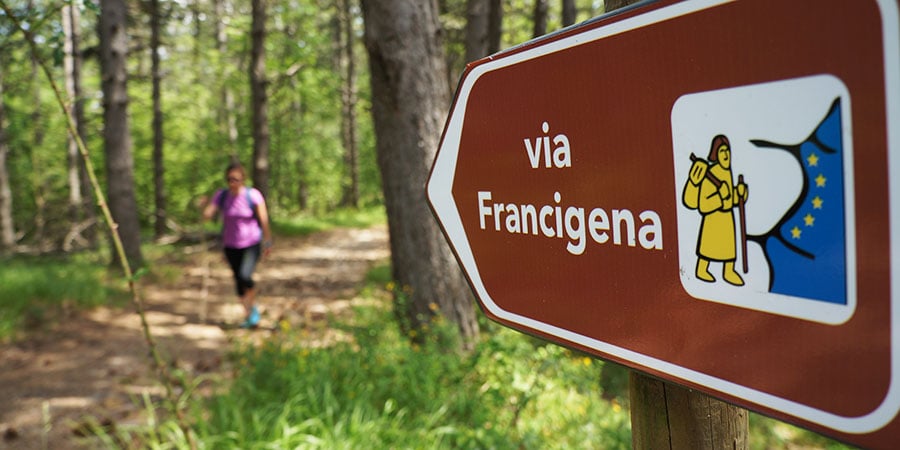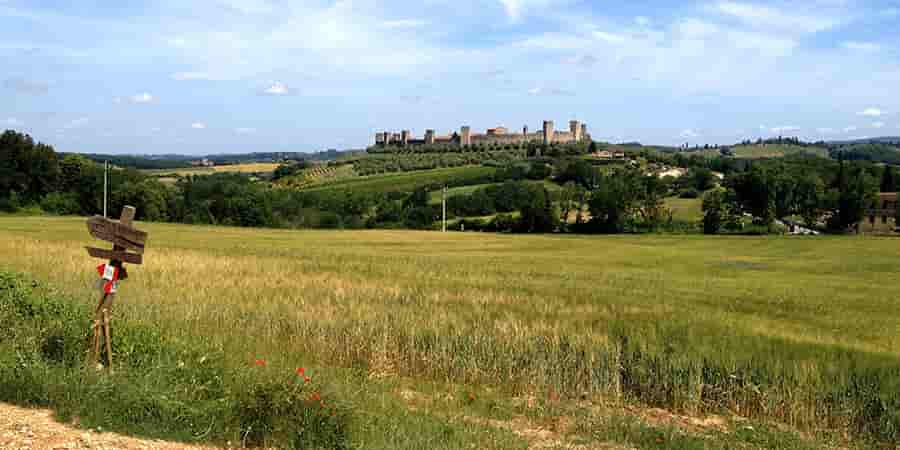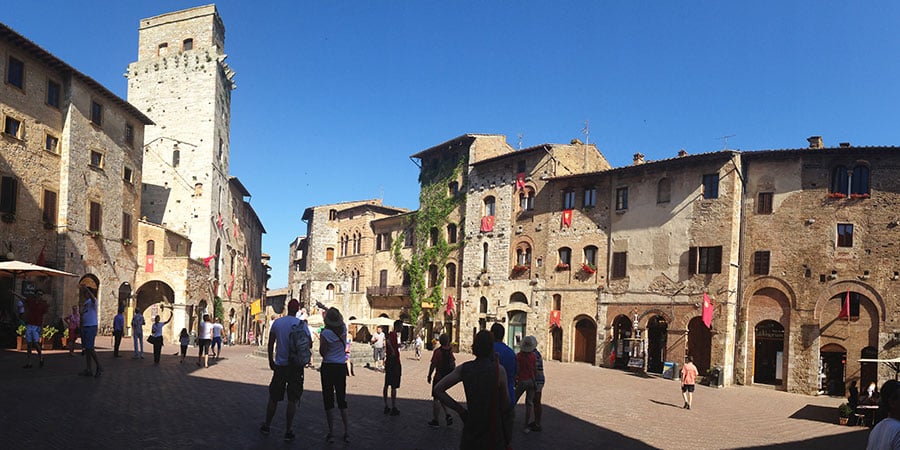What is the Via Francigena?
Like the Camino de Santiago, the Via Francigena is a historic pilgrimage route. It begins at Canterbury Cathedral in the UK and leads all the way to Rome, known as the Eternal City. Spanning 1,900 km, the route traces the path taken by Sigeric the Serious, the Archbishop of Canterbury, who made this pilgrimage to Rome in the 10th century and documented his journey in a diary. This ancient trail allows pilgrims to follow in historic footsteps across Europe, culminating in Rome.

Walking the full Via Francigena from Lucca to Rome takes about three weeks while cycling the full route takes up to 11 nights. However, many pilgrims choose to complete sections of the full Via Francigena over a few days or weeks.
When is the best time to walk the Via Francigena?
While awareness of the Via Francigena is increasing, it still attracts fewer pilgrims compared to the Camino de Santiago. Each year, between 2,000 and 3,000 people walk or cycle sections of the Via Francigena, while 446,035 pilgrims received their Compostela certificates in Santiago in 2023.
Popular Sections of the Route
Certain sections of the Via Francigena, such as Tuscany and areas closer to Rome, are the most popular. These are the regions where you are more likely to encounter fellow pilgrims, making the journey feel more social and shared.
Best Time to Travel
The best time to travel socially is from Spring to Autumn when more walkers and cyclists are on the route. While most sections can be walked in winter, mountain regions like the Alps and St Bernard’s Pass may be too challenging. Winter travel will likely be a more solitary experience.
Winter Considerations
During winter, some hotels and guest houses, especially in rural areas, may be closed, requiring additional transfers. If you’re considering travelling in winter, check availability with our team, and keep in mind that the weather will play a significant role in deciding the best time to travel.

Tuscany: A Popular Section
Tuscany is one of the most beloved sections of the Via Francigena. To avoid the intense heat of July and August, it’s best to visit in the spring or autumn. However, if you want to experience the famous Palio di Siena, plan your trip for those summer months.
Autumn in Tuscany
September and October offer pleasant temperatures, making them ideal for walking. During this time, you might also witness the regional wine harvest, adding a special touch to your journey.
The Final Stretch to Rome
The last section from Viterbo to Rome can be enjoyed throughout most of the year. However, for the best weather conditions, spring and autumn are recommended for this part of the pilgrimage.
Easter in Rome
Easter is a unique and special time to visit the Eternal City. Due to high demand, make sure to book accommodation well in advance if you plan to arrive during this period.
Planning Around Festivals
If you’re hoping to align your walk with festivals or events, ensure you secure your bookings early, as accommodation can be scarce during these times.
Expert Advice
Consult our travel specialists for personalised advice on the best time to walk your chosen section of the Via Francigena.

The Most Popular Via Francigena Tours
Walking Through Tuscany
One of the most popular sections is the eight-day walk from Lucca to Siena. This route allows walkers to experience Tuscany’s breathtaking beauty and rich history, passing through charming towns like San Gimignano and Siena. For those seeking a more leisurely pace, we offer an ‘Easy Walk’ option, starting in San Miniato and covering an average of 15 km daily.
Camino to Rome
The final section of the Via Francigena, from the medieval town of Viterbo to Rome, is perfect for pilgrims aiming to walk into the Eternal City and receive their Testimonium pilgrim certificate. This journey is ideal for those looking to complete their pilgrimage meaningfully.
Via Francigena Guided Tours
We also offer guided tours along the Via Francigena, departing on selected dates and focusing on specific sections. While the Via Francigena has grown in popularity, it remains less known than the Camino de Santiago, meaning pilgrims will encounter fewer fellow travellers along the route.
The St Francis Way
An alternative pilgrimage route to Rome is the St Francis Way. Inspired by St Francis of Assisi, this four-week trail takes pilgrims from Florence through Assisi, across the Rieti Valley, and into Rome. Although shorter, the St Francis Way is a challenging trek, recommended for experienced hikers.
For more details about our Via Francigena tours or to explore travel agent opportunities, please contact our team.